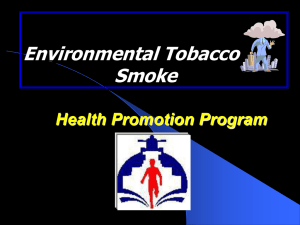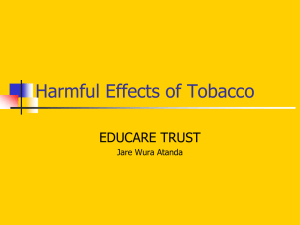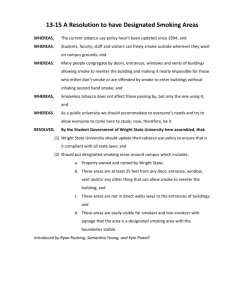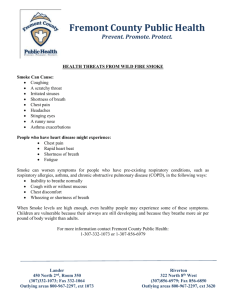Steps to Healthier Houses
advertisement
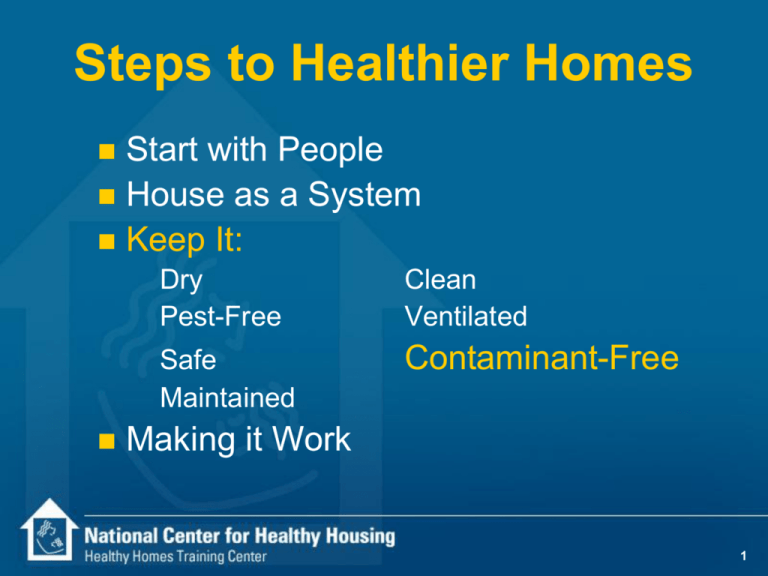
Steps to Healthier Homes Start with People House as a System Keep It: Dry Pest-Free Clean Ventilated Safe Maintained Contaminant-Free Making it Work 1 Contaminant Buying Decisions Intentionally Bring In Tobacco Smoke Pesticides — Volatile Organic Comp. — — — Building Materials Meth Labs Bedbugs and Mice — Boxes and Furniture Formaldehyde — Cardboard Boxes & Furniture Mice — Used Furniture & Mattresses Cockroaches — Thermostats & Fluorescent Lamps Asbestos — Air Fresheners & Cleaning Products Glues, Sprays & Coatings Building Materials Mercury — Sprays, Baits & Powders Along for the Ride Pressed Wood Products Lead — Used Building Supplies Environmental Tobacco Smoke Tobacco Spikes in Particle Levels RSP (cpm) 1000 750 500 250 1 2 Time (hours) Source:Indoor Air Quality, Infiltration and Ventilation in Residential Buildings NYSERDA 1985 [5] 3 Why Avoid ETS: Related Health Effects Increases the number of episodes and severity of symptoms for children with asthma Risk factor for new cases of asthma in children Responsible for 150,000 to 300,000 lower respiratory tract infections in infants and children less than 18 months of age 60% of US population has biological evidence of exposure to second hand smoke Smoke-Free Home Rules: State Performance 92-93 98-99 2003 % Increase Total 43.2% 60.2% 72.2% 67.1% Max. 69.6% 81.1% 88.8% 107.9% Min. 25.7% 38.9% 53.4% 27.6% Non-Smokers Exposed to Tobacco Smoke Have Increased Risk of Acute and Chronic Disease Respiratory illness (including arrested lung development) Asthma attacks and development Middle ear effusions Irritant effects Children affected by smoking caretaker What Can You Do About Tobacco Smoke in Homes and Cars? Quit, if you’re ready there’s help Don’t smoke around children Smoke outside Exhaust vent the places where people smoke Volatile Organic Compounds Air Fresheners Cleaning Products Sprays & Coatings Formaldehyde Carpets Vinyl Floors Drywall Hobbies Home Maintenance Volatile Organic Compounds EPA found concentration of VOC’s to be 2-5 times greater in the home. During or immediately after paint stripping activities, VOC levels can be 1,000 times higher than outdoors. Why Avoid VOCs? Potential health effects of VOCs: — Eye, nose, throat irritation — Headaches, nausea, coordination — Liver, kidney, and brain damage — Some can cause cancers — Child development VOC- AND SVOC-EMISSIONS FROM ADHESIVES, FLOOR COVERINGS AND COMPLETE FLOOR STRUCTURES [12] Emission Rate (ug/m2hr) 6000 5000 PVC carpet adhesive 4000 3000 2000 1000 0 0 5 10 15 Time (days) 20 25 30 Reduce Potential Sources Don’t use it if you don’t have to. Substitute with a product that has: — low VOC and particle emission — low toxicity and irritancy characteristics — low risk of chemical reactivity — low risk of fungal contamination — low maintenance requirements Steps to Control VOCs Control the source — Avoid using products that contain VOCs — Use lower VOC options (i.e. paints) — Keep containers sealed — Store away from air intake — Remove unwanted products from home Ventilate — Open doors and windows Third-Party Certifications Buildings — — — Green Communities – www.greencommunitiesonline.org Energy Star with Indoor Air Package – www.energystar.gov LEED for Homes – www.usgbc.org/LEED/homes/ Products and Services — — — — Green Seal – www.greenseal.org EcoLogo - www.ecologo.org EPA’s Design for the Environment – www.epa.gov/dfe GreenShield Certified (for pest control) – www.greenshieldcertified.org Industry Stewardship Programs Understand the Motivations & Research the Options Examples — — — — QualityPro Green for Pest Management – www.qualityprogreen.org Green Label for Carpet and Rugs – www.carpet-rug.org Environmental Stewardship Program for Kitchen Cabinet – www.greencabinetsource.org Ingredient Communications for Consumer Chemicals – www.cspa.org/public/media/info/cpici.html Other Programs Track Emerging Issues Healthyhomes.net listserve www.afhh.org/res/res_listserves.htm Phthalates from Vinyl Products Sulfur from Chinese Drywall — Corrodes Copper Heat Exchangers — Offensive Smell Cadmium in Jewelry? And then we have meth labs . . . What are the health & safety hazards? Explosive — Lithium metal, sodium, ether Flammable — Acetone, ethyl alcohol, solvents of all kinds Toxic — Iodine, red phosphorus, phosphine gas, anhydrous ammonia, methamphetamine, Caustic — Sodium hydroxide, hydrochloric acid, muriatic acid Key Messages It is easier to prevent exposure to contaminants then it is to remove them and treat their effects. Should contamination occur: control, contain, and clean-up. Contaminants are not always detectable by our senses.
